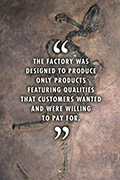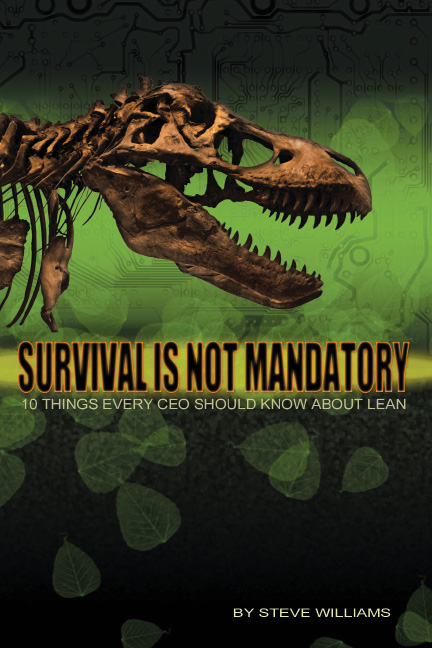In the global economy that is today’s business environment, there are no guarantees. In this environment, the big continue to get bigger through acquisition or elimination of the competition. Never before has US manufacturing had to look over our shoulder as we do now.
 Steve is an author, consultant and speaker with over 35 years of industry experience in a variety of manufacturing industries.
Steve is an author, consultant and speaker with over 35 years of industry experience in a variety of manufacturing industries.
Steve has written 5 international best-selling books on quality, lean/best practices & business strategy in addition to 150+ published articles, research and white papers.
He is the president of The Right Approach Consulting and specializes in ISO 9001, ISO 13485, and AS 9100 certifications and renewals.
Steve holds a BA in Organizational Management from Concordia University and an MBA from Cardinal Stritch University.
Chapter Summaries
-
Chapter 1
Survival Is Not Mandatory
In the global economy that is today’s business environment, there are no guarantees. In this environment, the big continue to get bigger through acquisition or elimination of the competition. Never before has US manufacturing had to look over our shoulder as we do now. Chapter One will take a historical look at some of the reasons that American products, jobs and technology have shifted to Asia at unprecedented rates, indicating that the threat has reached critical mass. Indeed, survival is not mandatory!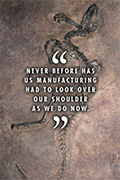
-
Chapter 2
A Painful History Lesson
Chapter Two reviews the history of lean, from its origins with Eli Whitney through Henry Ford to the gold standard of manufacturing excellence: the Toyota Motor Corporation. The history of lean presented here reveals the painful realization that US business leaders originally rejected lean, only to watch Toyota embrace and leverage the philosophy to propel Toyota to the top of the automotive world.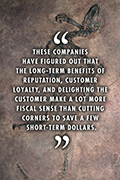
-
Chapter 3
Drive-By Lean
Through a series of case studies, Chapter Three will illustrate some common mistakes that organizations make when first trying to implement a lean program. Unfortunately, a failed lean implementation can result in bad press from business leaders on the benefits, or lack thereof, of lean manufacturing practices.
-
Chapter 4
Voice of the Customer
Understanding customer needs may seem like a no-brainer, but Chapter Four presents some interesting data that highlight just how frequently companies miss this mark. The author suggests that before you can define your process defects and opportunities, you need to understand the needs of your customers. This chapter presents the steps required to achieve this understanding in developing a solid Voice of the Customer program.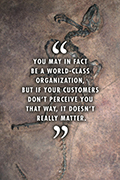
-
Chapter 5
The Lean Philosophy
Chapter Five provides an overview of the lean philosophy—the foundation of what has evolved into one of the most powerful improvement tools available to organizations. The author states, “If you only remember one thing from this book, remember that lean is about eliminating waste from your process.” With the understanding that every activity in a process must add value, non-value-adding steps must be eliminated from all processes. This chapter presents an overview of the steps required to implement a lean initiative in any organization.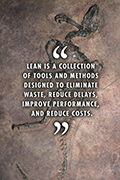
-
Chapter 6
The Seven Deadly Wastes
Waste can be defined as anything that is done with a cost attached to it that does not add value to the product. Following the author’s logic, then, non-value can be defined as anything the customer is not willing to pay for; in other words, waste. Chapter Six presents and defines each of “The Seven Deadly Wastes” and offers some potential countermeasures for each.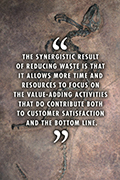
-
Chapter 7
Process Analysis
Once the Seven Deadly Wastes have been defined and understood, the next logical question is, “How do I identify these wastes in my processes?” This chapter presents the answer by reviewing the process analysis tools that will help an organization identify the value-add, and non-value-add, steps in their processes.
-
Chapter 8
Six Sigma-Why 99% Yield Is Not Good Enough
Chapter Eight presents Six Sigma as a lean methodology for eliminating process waste and maintaining process control through the problem-solving system called DMAIC (Define, Measure, Analyze, Improve, Control). The author presents how to use the DMAIC collection of tools to identify, analyze and eliminate sources of variation in a process.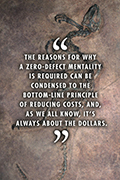
-
Chapter 9
The Lean Toolkit
The lean toolkit is a collection of lean tools that illustrates the process improvement synergy between lean practices and Six Sigma. Pareto analysis, cause and effect diagramming, design of experiments (DOE), poka-yoke, and process capability are some of the tools explored in Chapter Nine.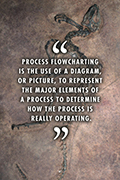
-
Chapter 10
If Willie Wonka Can Do It, So Can You!
Chapter Ten discusses the wide and limitless supply of excuses for why lean sigma will not work in your organization. The author has developed a lighthearted case study that takes a lean look at a very unlikely organization: Willie Wonka’s Chocolate Factory. Although this is a very tongue-in-cheek look at a fictional company, the concepts and theory liberally applied by the author’s imagination are technically sound and based in fact. The author suggests that if lean can be successfully implemented in the fantastic setting of Willie Wonka’s Chocolate Factory, it most certainly will work in your company.